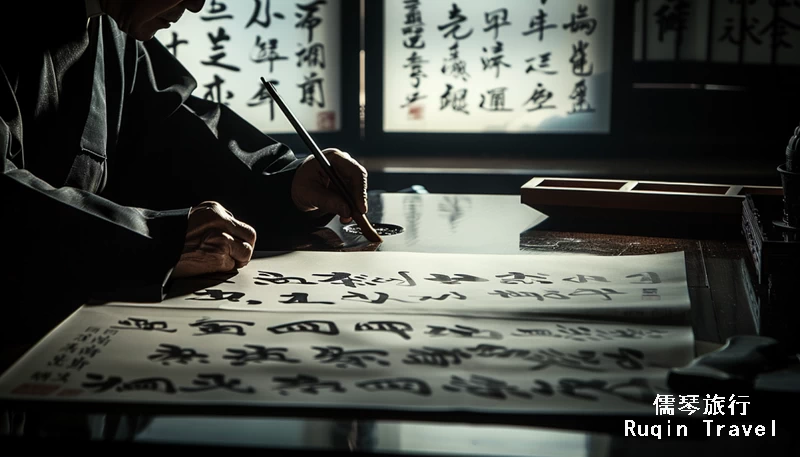Chinese calligraphy is more than just writing. It’s an art form that has flourished for thousands of years. For foreign tourists visiting China, understanding this beautiful tradition can enrich their travel experience.
This article will delve into the history, styles, tools, and techniques of Chinese calligraphy. Let’s explore how you can appreciate and even try your hand at this fascinating art.
A Brief History of Chinese Calligraphy
First, let’s look at the origins. Chinese calligraphy has a history that dates back over 3,000 years. It began during the Shang Dynasty with oracle bone inscriptions. These early forms of writing were used for divination and recording significant events.
Next came the Zhou Dynasty, which saw the development of bronze inscriptions. These were more structured and formal. However, it was during the Han Dynasty that calligraphy truly began to flourish. During this period, the Chinese script evolved significantly, leading to the creation of the standard script.
As we move to the Tang and Song Dynasties, calligraphy reached its peak. Renowned calligraphers like Wang Xizhi and Su Shi left their marks. Their works are still studied and admired today. Additionally, each dynasty contributed unique styles and innovations, enriching the art form.
Understanding the Styles of Chinese Calligraphy
Chinese calligraphy features several distinct styles. Each style has its own rules and characteristics. Here, we’ll explore the five major ones.
Seal Script (篆书)
First, there’s the Seal Script, also known as Zhuan Shu. This style is ancient and was used primarily for official seals. It’s characterized by its uniformity and intricate lines. Though rarely used in modern writing, it remains significant in traditional art and seals.
Clerical Script (隶书)
Next is the Clerical Script or Li Shu. This style emerged during the Han Dynasty. It’s known for its straight, flat strokes and clear structure. It’s easier to read compared to Seal Script. This script was used for official documents and inscriptions.
Regular Script (楷书)
The Regular Script, also called Kai Shu, is the most common style today. It developed during the Wei and Jin Dynasties. This style is easy to read and write. It is often used for printing and educational purposes. Many beginners start learning Chinese calligraphy with this script.
Running Script (行书)
Running Script or Xing Shu offers more fluidity. It emerged in the Eastern Han Dynasty. The strokes are more connected, making it faster to write. This style is used for personal letters and informal writings. It balances between the formality of Regular Script and the freedom of Cursive Script.
Cursive Script (草书)
Lastly, we have the Cursive Script, known as Cao Shu. This style is highly expressive and artistic. It allows for swift and flowing strokes. However, it can be difficult to read for those unfamiliar with it. Cursive Script is often used in calligraphic art rather than practical writing.
Tools of the Trade
To appreciate Chinese calligraphy, one must understand the essential tools. These tools are collectively known as the Four Treasures of the Study.
Brush (笔)
First, the brush. It is the most critical tool in calligraphy. Traditional brushes are made from animal hair and bamboo. The type of hair used can affect the brush’s flexibility and the texture of the strokes. Brushes come in various sizes, each serving different purposes.
Ink (墨)
Next, the ink. Traditionally, ink is made from soot and animal glue. It’s often sold in solid ink sticks. To use it, one must grind the stick on an inkstone with water. This process is meditative and helps the calligrapher prepare mentally.
Paper (纸)
The third treasure is paper. Rice paper, also known as Xuan paper, is commonly used. It absorbs ink well and allows for smooth strokes. The quality of the paper can significantly affect the final artwork.
Inkstone (砚)
Finally, the inkstone. This tool is used to grind the ink stick and mix it with water. A good inkstone ensures a smooth and consistent ink flow. Inkstones come in various shapes and sizes, often carved with intricate designs.
Techniques and Practice
Learning Chinese calligraphy requires patience and practice. Here are some basic techniques to get started.
Holding the Brush
First, learn to hold the brush correctly. Hold it upright, between the thumb and the first two fingers. Your hand should be steady, but not tense.
Basic Strokes
Next, practice the basic strokes. Chinese characters are built from these fundamental elements. Start with horizontal, vertical, and diagonal strokes. Mastery of these basics is crucial before moving on to complex characters.
Consistency and Rhythm
Additionally, focus on consistency and rhythm. Each stroke should be even and smooth. The rhythm of your writing should be steady. This creates a harmonious flow in your calligraphy.
Copying Masterpieces
A traditional method of learning is by copying masterpieces. Find works by renowned calligraphers and replicate them. This practice helps you understand the structure and balance of Chinese characters.
Appreciating Chinese Calligraphy
To fully appreciate Chinese calligraphy, it’s essential to view it as more than writing. It’s an art that reflects the calligrapher’s personality, emotions, and thoughts.
Visiting Calligraphy Exhibits
When in China, visit calligraphy exhibits and museums. These places offer a glimpse into the rich history and diversity of the art. You’ll see works by ancient and modern calligraphers, each with their unique style.
Participating in Workshops
Additionally, consider joining a calligraphy workshop. Many cultural centers and studios offer classes for beginners. These workshops provide hands-on experience and personalized guidance.
Collecting Calligraphy
For enthusiasts, collecting calligraphy can be rewarding. Look for pieces that resonate with you. Authentic works by famous calligraphers can be valuable investments.
The art of Chinese calligraphy is a window into China’s rich cultural heritage. From its ancient origins to its modern-day practice, it remains a revered art form. Whether you’re visiting an exhibit, participating in a workshop, or simply practicing basic strokes, you’ll find beauty and depth in Chinese calligraphy.
As you explore China, take the time to appreciate this ancient art. It will undoubtedly enhance your understanding and enjoyment of Chinese culture. More Chinese Cultural Insights.
More China Survival Guide
Prepare for smooth travels with the China Survival Guide, your go-to resource for practical advice on navigating daily life in China. From essential language tips and transportation know-how to safety guidelines and local etiquette.



